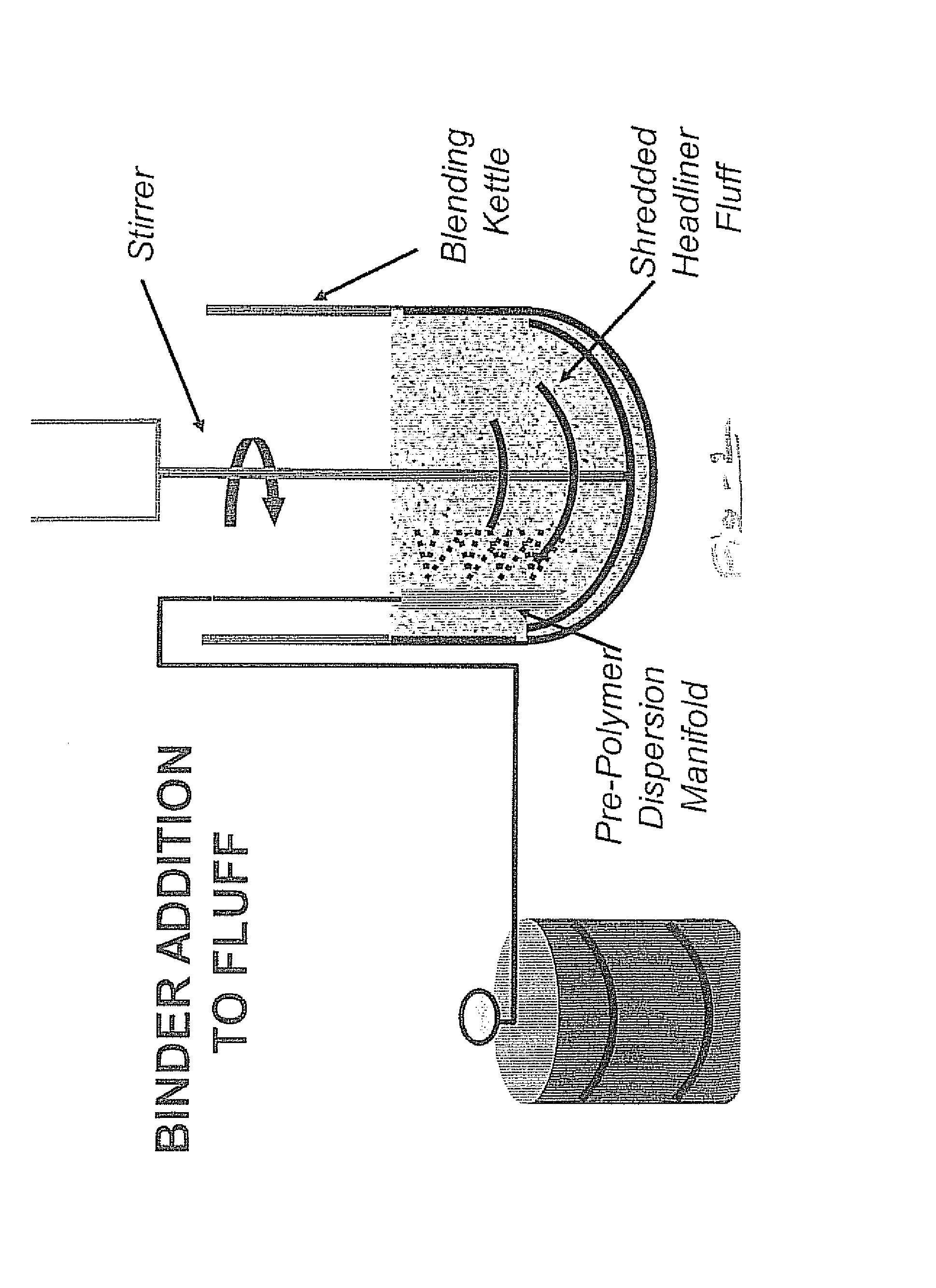Apparatus and method for recycling scrap, including automotive interior trim scrap
a technology for automotive interiors and scraps, applied in the field of recycling, can solve the problems of high cost of cleaning and separating each polymer, high cost, and inability to convert post-industrial or post-consumer automotive interior soft trim composites into finished trim panels, etc., and achieve excellent physical properties and excellent adhesion. excellent
- Summary
- Abstract
- Description
- Claims
- Application Information
AI Technical Summary
Benefits of technology
Problems solved by technology
Method used
Image
Examples
example 1
[0042]Automotive headliner scrap material is shredded using a 75 HP granulator commercially available from Rapid at a 450 lbs / hr rate and using a 1″ screen. The resulting fluff (22.2 g) was mixed for 2 minutes with 2.7 g (10.7% by weight of total blend) of isocyanate binder (2100 cps, 11.54% NCO) commercially available under the trade name Mistabond H3174 from Marchem, and 0.22 g of water (0.87% by weight of total blend) using a laboratory Hobart mixer at ambient temperature (22-25° C.). This mixture, which weighted 25.12 g, was transferred into a 4.5″×4.5″ mold and compressed at 2200 psi. Heat and compression were applied using a Carver press. The sample was left in the press for 6 minutes at a temperature of 132° C. (270° F.). The produced plaque was 5.1 mm thick and had a surface density of 178.6 g / ft2. It was flexible and could be bent without breaking.
example 2
[0043]50.0 g of automotive headliner fluff produced as described in Example 1, was mixed for 2 minutes with 6.0 g (10.6% by weight of total blend) of isocyanate binder (2100 cps, 11.54% NCO) commercially available under the trade name Mistabond H3174 from Marchem, and 0.5 g of water (0.88% by weight of total blend) using a laboratory Hobart mixer at ambient temperature (22-25° C.). This mixture, which weighted 56.5 g, was transferred into a 4.5″×4.5″ mold and compressed at 2200 psi. Heat and compression were applied using a Carver press. Sample was left in the press for 6 minutes at a temperature of 132° C. (270° F.). Produced plaque was 5.6 mm thick and had a surface density of 401.8 g / ft2. It was stiff and could not be bent by hand.
example 3
[0044]110.0 g of automotive headliner fluff produced as described in Example 1, was mixed for 2 minutes with 27.6 g (19.9% by weight of total blend) of isocyanate binder (2100 cps, 11.54% NCO) commercially available under the trade name Mistabond H3174 from Marchem and 1.0 g of catalyst commercially available under the trade name Mistabond P1064 (3.6% by weight of binder) from Marchem, using a laboratory Hobart mixer at ambient temperature (22-25° C.). This mixture, which weighted 138.6 g, was transferred into a 12″×12″ mold and compressed at 2200 psi and room temperature for 1 hr. Prior to transfer of the mixture into the mold, the mold was sprayed with a mold release composition commercially available under the trade name MR-515 from Chem-Trend. The produced plaque was 3.0 mm thick and had a surface density of 138.6 g / ft2. It was flexible and could be bent without breaking.
PUM
| Property | Measurement | Unit |
|---|---|---|
| temperature | aaaaa | aaaaa |
| temperature | aaaaa | aaaaa |
| weight | aaaaa | aaaaa |
Abstract
Description
Claims
Application Information
 Login to View More
Login to View More - R&D
- Intellectual Property
- Life Sciences
- Materials
- Tech Scout
- Unparalleled Data Quality
- Higher Quality Content
- 60% Fewer Hallucinations
Browse by: Latest US Patents, China's latest patents, Technical Efficacy Thesaurus, Application Domain, Technology Topic, Popular Technical Reports.
© 2025 PatSnap. All rights reserved.Legal|Privacy policy|Modern Slavery Act Transparency Statement|Sitemap|About US| Contact US: help@patsnap.com



